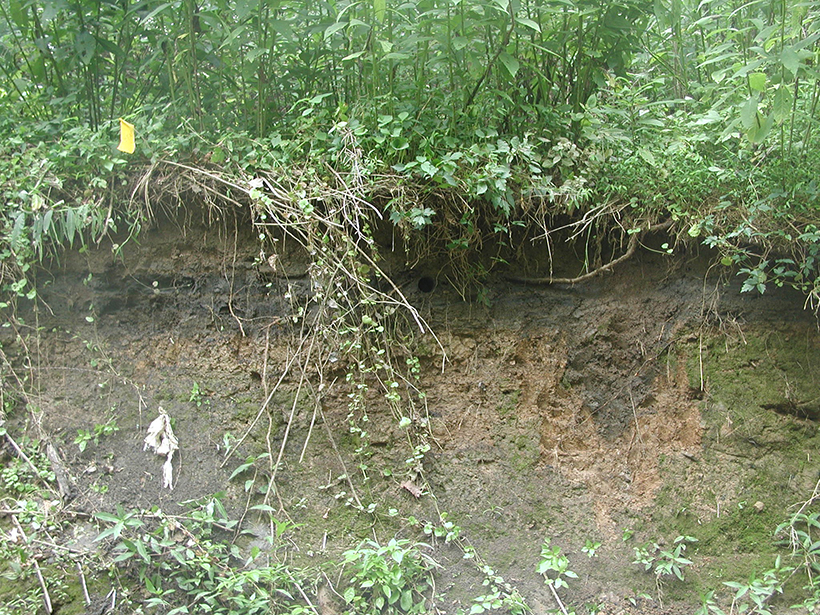Soils play an important role in the world’s carbon cycle by exchanging carbon with the atmosphere and hydrosphere. Soil carbon storage regulates our climate and provides the basis for ecosystem and agricultural productivity. Understanding the role of soils is vital to these essential ecosystem services.
Meeting carbon storage and agricultural research commitments requires understanding factors influencing the resilience and vulnerability of soil carbon.
The Conference of the Parties to the United Nations Framework Convention on Climate Change (November–December 2015) focused attention on carbon stabilization and developed an initiative to increase carbon stored in soil by 4 parts per 1000 each year. The White House Office of Science and Technology Policy called for a commitment to research and education in food and agriculture from all sectors. Meeting these commitments requires a comprehensive understanding of factors influencing the resilience and vulnerability of soil carbon (Figure 1).
To address these needs, the Carbon Cycle Interagency Working Group (CCIWG) convened the International Decade of Soils (2015–2024) Workshop at the University Corporation for Atmospheric Research (UCAR) in Boulder, Colo., in March 2016.

The workshop’s primary goals were to improve understanding of the vulnerability and resilience of carbon in soils and to improve prediction of the critical role of soils in generating feedbacks to the climate. An additional goal was to inform the second State of the Carbon Cycle Report (SOCCR-2), a special report of the U.S. Sustained National Climate Assessment scheduled for release in 2018.
Breakout sessions were organized around three themes:
- vulnerability of soils to global change and the potential for restoration
- factors influencing soil carbon stabilization and destabilization
- new modeling frameworks for predicting soil carbon dynamics
Theme 1 participants discussed the importance to predictions of soil carbon vulnerability and resilience of such overarching processes as disturbance, land use, and erosion. Theme 2 participants affirmed that to represent these processes in models, it is necessary to identify the types and availability of experimental and observational data for model development and testing. Theme 3 participants discussed the growing set of microbe-enabled models and recognized that the benefits of different model frameworks and levels of biological complexity have not been as systematically evaluated as other approaches.
The workshop generated three frameworks for action:
- a method using soil order classifications for assessing and predicting soil vulnerability with respect to carbon loss and potential for mitigation
- a synthesis of proxies for modeling carbon cycling, such as carbon use efficiency, mineral sorption, and microbial community assembly
- measurable compartments for soil carbon models that consider mineral protection, sorption of dissolved organic carbon, aggregate formation, and particulate organic matter
Workshop participants generated a survey to seek input from soil scientists on the impacts of global change on soil carbon.
Supporting framework 1, workshop participants generated a survey to seek input from soil scientists on the impacts of global change on soil carbon. All three frameworks are being developed into forward-looking conceptual publications.
The named authors thank co-organizers Rose Abramoff and Margaret Torn of Lawrence Berkeley National Laboratory, Julie Jastrow of Argonne National Laboratory, and Gyami Shrestha of the U.S. Carbon Cycle Science Program. The organizers also thank the workshop participants for their contributions, UCAR for meeting space, and CCIWG for funding.
ORNL is managed by UT-Battelle, LLC, for the U.S. Department of Energy under contract DE-AC05-00OR22725. PNNL is operated for the U.S. Department of Energy by Battelle Memorial Institute under contract DE-AC05-76RL01830.
—Melanie A. Mayes, Environmental Science Division and Climate Change Science Institute, Oak Ridge National Laboratory, Oak Ridge, Tenn.; email: [email protected]; Kate Lajtha, Department of Crop and Soil Sciences, Oregon State University, Corvallis; and Vanessa Bailey, Biological Sciences Division, Pacific Northwest National Laboratory, Richland, Wash.
Citation:
Mayes, M. A.,Lajtha, K., and Bailey, V. (2016), Advancing soil carbon cycle science, Eos, 97, https://doi.org/10.1029/2016EO056881. Published on 12 August 2016.
Text © 2016. The authors. CC BY-NC-ND 3.0
Except where otherwise noted, images are subject to copyright. Any reuse without express permission from the copyright owner is prohibited.

